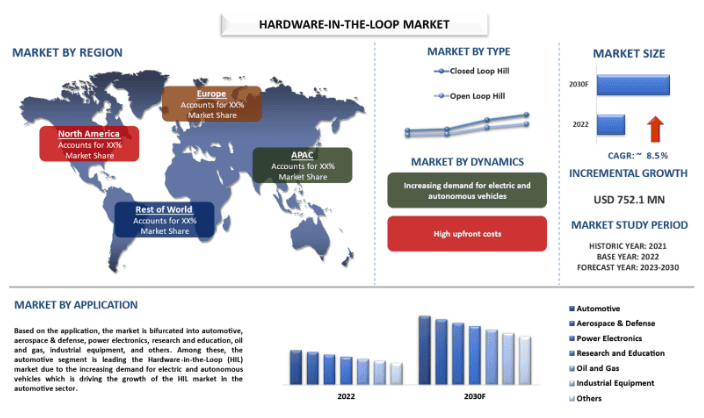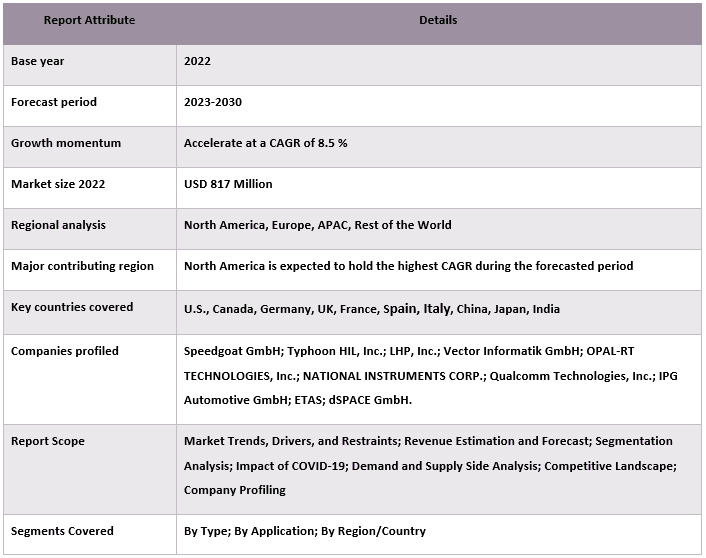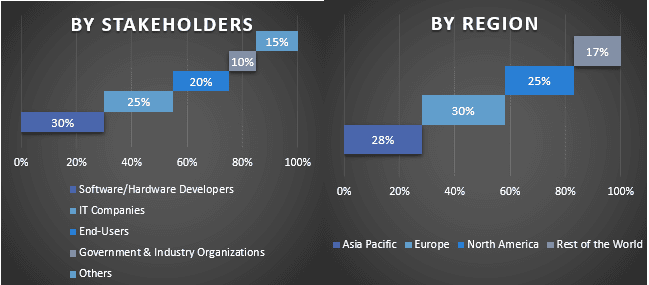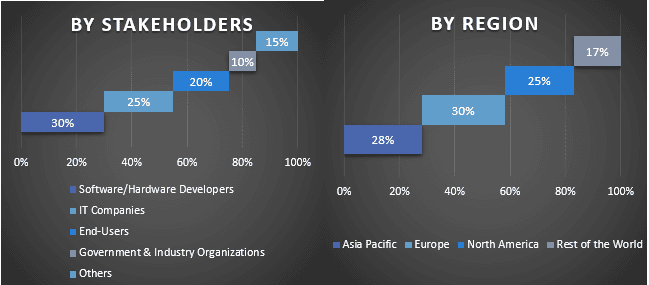Emphasis On Type (Closed Loop Hill, And Open Loop Hill); Application (Automotive, Aerospace & Defense, Power Electronics, Research And Education, Oil And Gas, Industrial Equipment, And Others) And Region/Country.

The Hardware-In-The-Loop (HIL) Market was valued at 817 million in 2022 and is expected to grow at a steady rate of around 8.5% in the forecasted period (2023-2030) owing to the increasing demand for advanced driver assistance systems (ADAS) and autonomous vehicles, along with the rising adoption of electric vehicles, are key factors driving the growth of the HIL market. Additionally, government regulations and standards related to vehicle safety and emissions are also contributing to the growth of the HIL market. For instance, the US Environmental Protection Agency (EPA) and the National Highway Traffic Safety Administration (NHTSA) have proposed stringent vehicle emission standards to fight climate change and improve air quality for communities.
Some of the major players operating in the market include Speedgoat GmbH; Typhoon HIL, Inc.; LHP, Inc.; Vector Informatik GmbH; OPAL-RT TECHNOLOGIES, Inc.; NATIONAL INSTRUMENTS CORP.; Qualcomm Technologies, Inc.; IPG Automotive GmbH; ETAS; dSPACE GmbH.
Insights Presented in the Report
“Among application, the automotive segment holds largest share of the market during forecast period.”
Based on the application, the market is bifurcated into automotive, aerospace & defense, power electronics, research and education, oil and gas, industrial equipment, and others. Among these, the automotive segment is leading the Hardware-in-the-Loop (HIL) market due to the increasing demand for electric and autonomous vehicles which is driving the growth of the HIL market in the automotive sector. However, the aerospace and defense sector are also expected to experience substantial growth in the demand for HIL systems due to the accelerated pace of technological advancements.
“North America to hold a significant share in the market.”
The North America region is dominating the Hardware-in-the-Loop (HIL) market due to several factors. The region’s competitiveness and dominance in global markets, particularly in the technology and automotive sectors, have contributed to the growth of the HIL market. The United States, as a major player in the global economy, has a significant influence on the HIL market, given its dominance in technology, e-commerce, and stock markets. Additionally, the presence of key market players and the widespread utilization of HIL systems in sectors such as automotive, aerospace, and industrial automation have further propelled the market’s growth in North America.
Hardware-In-The-Loop (HIL) Market Report Coverage

Reasons to buy this report:
Customization Options:
The global Hardware-In-The-Loop (HIL) market can further be customized as per the requirement or any other market segment. Besides this, UMI understands that you may have your own business needs, hence feel free to contact us to get a report that completely suits your requirements.
1. Market Introduction
2. Research Methodology Or Assumption
3. Market Synopsis
4. Executive Summary
5. Hardware-in-the-loop (hil) Market Revenue (usd Mn), 2020-2030f
6. Market Insights By Type
7. Market Insights By Application
8. Market Insights By Region
9. Hardware-in-the-loop (hil) Market Dynamics
10. Hardware-in-the-loop (hil) Market Opportunities
11. Hardware-in-the-loop (hil) Market Trends
12. Demand And Supply-side Analysis
13. Value Chain Analysis
14. Pricing Analysis
15. Strategic Insights
16. Competitive Scenario
17. Company Profiled
18. Disclaimer
Research Methodology for the Hardware-In-The-Loop (HIL) Market Analysis
(2023-2030)
Analyzing the historical market, estimating the current market, and forecasting the future market of the global Hardware-In-The-Loop (HIL) market were the three major steps undertaken to create and analyze the adoption of Hardware-In-The-Loop (HIL) market in major regions globally. Exhaustive secondary research was conducted to collect the historical market numbers and estimate the current market size. Secondly, to validate these insights, numerous findings and assumptions were taken into consideration. Moreover, exhaustive primary interviews were also conducted, with industry experts across the value chain of the global Hardware-In-The-Loop (HIL) market. Post assumption and validation of market numbers through primary interviews, we employed a top-down/bottom-up approach to forecasting the complete market size. Thereafter, market breakdown and data triangulation methods were adopted to estimate and analyze the market size of segments and sub-segments of the industry pertains to. Detailed methodology is explained below:
Analysis of Historical Market Size
Step 1: In-Depth Study of Secondary Sources:
Detail secondary study was conducted to obtain the historical market size of the Hardware-In-The-Loop (HIL) market through company internal sources such as annual reports & financial statements, performance presentations, press releases, etc., and external sources including journals, news & articles, government publications, competitor publications, sector reports, third-party database, and other credible publications.
Step 2: Market Segmentation:
After obtaining the historical market size of the Hardware-In-The-Loop (HIL) market, we conducted a detailed secondary analysis to gather historical market insights and share for different segments & sub-segments for major regions. Major segments are included in the report as type and application. Further country-level analyses were conducted to evaluate the overall adoption of testing models in that region.
Step 3: Factor Analysis:
After acquiring the historical market size of different segments and sub-segments, we conducted a detailed factor analysis to estimate the current market size of the Hardware-In-The-Loop (HIL) market. Further, we conducted factor analysis using dependent and independent variables such as various type and applications of the Hardware-In-The-Loop (HIL) market. A thorough analysis was conducted of demand and supply-side scenarios considering top partnerships, mergers and acquisitions, business expansion, and product launches in the Hardware-In-The-Loop (HIL) market sector across the globe.
Current Market Size Estimate & Forecast
Current Market Sizing: Based on actionable insights from the above 3 steps, we arrived at the current market size, key players in the global Hardware-In-The-Loop (HIL) market, and market shares of the segments. All the required percentage shares split, and market breakdowns were determined using the above-mentioned secondary approach and were verified through primary interviews.
Estimation & Forecasting: For market estimation and forecast, weights were assigned to different factors including drivers & trends, restraints, and opportunities available for the stakeholders. After analyzing these factors, relevant forecasting techniques i.e., the top-down/bottom-up approach were applied to arrive at the market forecast for 2030 for different segments and sub-segments across the major markets globally. The research methodology adopted to estimate the market size encompasses:
Market Size and Share Validation
Primary Research: In-depth interviews were conducted with the Key Opinion Leaders (KOLs) including Top Level Executives (CXO/VPs, Sales Head, Marketing Head, Operational Head, Regional Head, Country Head, etc.) across major regions. Primary research findings were then summarized, and statistical analysis was performed to prove the stated hypothesis. Inputs from primary research were consolidated with secondary findings, hence turning information into actionable insights.
Split of Primary Participants in Different Regions

Market Engineering
The data triangulation technique was employed to complete the overall market estimation and to arrive at precise statistical numbers for each segment and sub-segment of the global Hardware-In-The-Loop (HIL) market. Data was split into several segments & sub-segments post studying various parameters and trends in the areas of type and application in the global Hardware-In-The-Loop (HIL) market.
The main objective of the Global Hardware-In-The-Loop (HIL) Market Study
The current & future market trends of the global Hardware-In-The-Loop (HIL) market were pinpointed in the study. Investors can gain strategic insights to base their discretion for investments on the qualitative and quantitative analysis performed in the study. Current and future market trends determined the overall attractiveness of the market at a regional level, providing a platform for the industrial participant to exploit the untapped market to benefit from a first-mover advantage. Other quantitative goals of the studies include:

Q1: What is the current market size and growth potential of the global Hardware-In-The-Loop (HIL) market?
Q2: What are the driving factors for the growth of the global Hardware-In-The-Loop (HIL) market?
Q3: Which segment has the largest share of the global Hardware-In-The-Loop (HIL) market by Type?
Q4: Which region will dominate the global Hardware-In-The-Loop (HIL) Market?
Q5: Who are the key players operating in the global Hardware-In-The-Loop (HIL) Market?
Customers who bought this item also bought